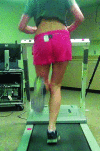CURRENT CONCEPTS IN BIOMECHANICAL INTERVENTIONS FOR PATELLOFEMORAL PAIN
- PMID: 27904791
- PMCID: PMC5095941
CURRENT CONCEPTS IN BIOMECHANICAL INTERVENTIONS FOR PATELLOFEMORAL PAIN
Abstract
Patellofemoral pain (PFP) has historically been a complex and enigmatic issue. Many of the factors thought to relate to PFP remain after patients' symptoms have resolved making their clinical importance difficult to determine. The tissue homeostasis model proposed by Dye in 2005 can assist with understanding and implementing biomechanical interventions for PFP. Under this model, the goal of interventions for PFP should be to re-establish patellofemoral joint (PFJ) homeostasis through a temporary alteration of load to the offended tissue, followed by incrementally restoring the envelope of function to the baseline level or higher. High levels of PFJ loads, particularly in the presence of an altered PFJ environment, are thought to be a factor in the development of PFP. Clinical interventions often aim to alter the biomechanical patterns that are thought to result in elevated PFJ loads while concurrently increasing the load tolerance capabilities of the tissue through therapeutic exercise. Biomechanics may play a role in PFJ load modification not only when addressing proximal and distal components, but also when considering the involvement of more local factors such as the quadriceps musculature. Biomechanical considerations should consider the entire kinetic chain including the hip and the foot/ankle complex, however the beneficial effects of these interventions may not be the result of long-term biomechanical changes. Biomechanical alterations may be achieved through movement retraining, but the interventions likely need to be task-specific to alter movement patterns. The purpose of this commentary is to describe biomechanical interventions for the athlete with PFP to encourage a safe and complete return to sport.
Level of evidence: 5.
Keywords: Foot; hip; knee; rehabilitation; running.
Figures






Similar articles
-
Patellofemoral joint stress during stair ascent and descent in persons with and without patellofemoral pain.Gait Posture. 2002 Oct;16(2):115-23. doi: 10.1016/s0966-6362(02)00090-5. Gait Posture. 2002. PMID: 12297253
-
Patellofemoral stress during walking in persons with and without patellofemoral pain.Med Sci Sports Exerc. 2002 Oct;34(10):1582-93. doi: 10.1097/00005768-200210000-00009. Med Sci Sports Exerc. 2002. PMID: 12370559
-
Patellofemoral Joint Stress during Running with Added Load in Females.Int J Sports Med. 2020 Jun;41(6):412-418. doi: 10.1055/a-1088-5467. Epub 2020 Feb 11. Int J Sports Med. 2020. PMID: 32045950
-
The influence of altered lower-extremity kinematics on patellofemoral joint dysfunction: a theoretical perspective.J Orthop Sports Phys Ther. 2003 Nov;33(11):639-46. doi: 10.2519/jospt.2003.33.11.639. J Orthop Sports Phys Ther. 2003. PMID: 14669959 Review.
-
Rethinking patellofemoral pain: Prevention, management and long-term consequences.Best Pract Res Clin Rheumatol. 2019 Feb;33(1):48-65. doi: 10.1016/j.berh.2019.02.004. Epub 2019 Feb 22. Best Pract Res Clin Rheumatol. 2019. PMID: 31431275 Review.
Cited by
-
Patellofemoral Joint Loading Progression Across 35 Weightbearing Rehabilitation Exercises and Activities of Daily Living.Am J Sports Med. 2023 Jul;51(8):2110-2119. doi: 10.1177/03635465231175160. Epub 2023 Jun 5. Am J Sports Med. 2023. PMID: 37272685 Free PMC article.
-
Effects of different sensory integration tasks on the biomechanical characteristics of the lower limb during walking in patients with patellofemoral pain.Front Bioeng Biotechnol. 2024 Aug 27;12:1441027. doi: 10.3389/fbioe.2024.1441027. eCollection 2024. Front Bioeng Biotechnol. 2024. PMID: 39257445 Free PMC article.
-
Vastus lateralis and vastus medialis produce distinct mediolateral forces on the patella but similar forces on the tibia in the rat.J Biomech. 2018 Nov 16;81:45-51. doi: 10.1016/j.jbiomech.2018.09.007. Epub 2018 Sep 13. J Biomech. 2018. PMID: 30269930 Free PMC article.
-
Adaptation of muscle activation after patellar loading demonstrates neural control of joint variables.Sci Rep. 2019 Dec 30;9(1):20370. doi: 10.1038/s41598-019-56888-9. Sci Rep. 2019. PMID: 31889142 Free PMC article.
-
Symptomatic os trigonum in national level javelin thrower: a case report.J Can Chiropr Assoc. 2018 Dec;62(3):202-210. J Can Chiropr Assoc. 2018. PMID: 30662075 Free PMC article.
References
-
- Dye SF. The pathophysiology of patellofemoral pain: A tissue homeostasis perspective. Clin Orthop Relat Res. 2005(436):100-110. - PubMed
-
- Murray NB Gabbett TJ Townshend AD Hulin BT McLellan CP. Individual and combined effects of acute and chronic running loads on injury risk in elite Australian footballers. Scand J Med & Sci Sports. 2016; epub ahead of print, 2016 Jul 15. - PubMed
-
- Gabbett TJ Kennelly S Sheehan J, et al. If overuse injury is a ‘training load error’, should undertraining be viewed the same way? Br J Sports Med. 2016;50(17):1017-1018. - PubMed
LinkOut - more resources
Full Text Sources
Research Materials
